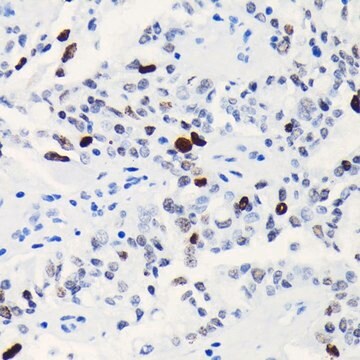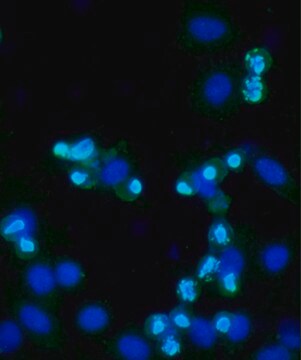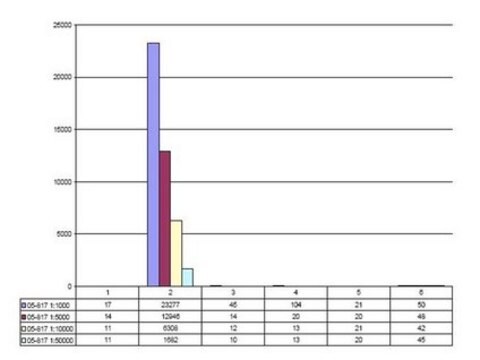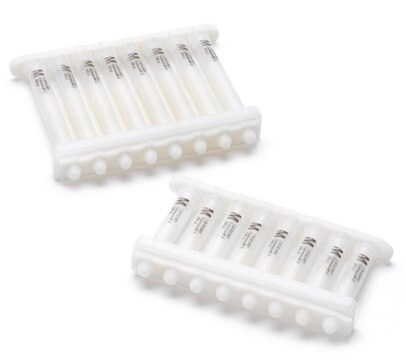17-10269
ChIPAb+ Phospho-Histone H3 (Ser28) Antibody
from rabbit, purified by affinity chromatography
Synonyme(s) :
Histone H3.1t, H3/t, H3t, H3/g
About This Item
Produits recommandés
Source biologique
rabbit
Niveau de qualité
Forme d'anticorps
affinity purified immunoglobulin
Clone
polyclonal
Produit purifié par
affinity chromatography
Espèces réactives
mouse, human
Fabricant/nom de marque
ChIPAb+
Upstate®
Technique(s)
ChIP: suitable
dot blot: suitable
immunocytochemistry: suitable
inhibition assay: suitable (peptide)
western blot: suitable
Numéro d'accès NCBI
Numéro d'accès UniProt
Conditions d'expédition
dry ice
Description générale
The ChIPAb+ Phospho-Histone H3 (Ser28) set includes the Phospho-Histone H3 (Ser28) antibody, a Normal Rabbit IgG, and control primers which amplify a 166 bp region of the human GAPDH promoter. The Phospho-Histone H3 (Ser28) and negative controls are supplied in a scalable "per ChIP" reaction size and can be used to functionally validate the precipitation of Phospho-Histone H3 (Ser28)-associated chromatin.
Immunogène
Application
Representative lot data.
Sonicated chromatin prepared from untreated or colcemid-treated HeLa cells (1 X 106 cell equivalents per IP) were subjected to chromatin immunoprecipitation using either 5 µl Normal rabbit IgG, or 5 µl Anti-phospho-Histone H3 (Ser28) and the Magna ChIP® A Kit (Cat. # 17-610). Successful immunoprecipitation of phospho-Histone H3 (Ser28)- associated DNA fragments was verified by qPCR using ChIP Primers, human GAPDH promoter region for untreated and treated chromatin samples (Figure 2). Data is presented as percent input of each IP sample relative to input chromatin for each amplicon and ChIP sample as indicated.
Please refer to the EZ-Magna ChIP A (Cat. # 17-408) or EZ-ChIP (Cat. # 17-371) protocol for experimental details.
Western Blot Analysis:
Representative lot data.
HeLa acid extract (lane 1) and recombinant Histone H3 (lane 2) were probed with Anti-phospho-Histone H3 (Ser28) (1:2,000 dilution).
Proteins were visualized using a Donkey Anti-Rabbit IgG secondary antibody conjugated to HRP and a chemiluminescence detection system. (Figure 3)
Arrow indicates phospho-Histone H3 (Ser28) (~17 kDa).
Dot Blot Specificity Analysis:
Representative lot data.
Histone peptides with various modifications (see table) were probed with Anti-phospho-Histone H3 (Ser28). Proteins were visualized using a Donkey Anti-Rabbit IgG secondary antibody conjugated to HRP and a chemiluminescence detection system. (Figure 4)
Immunocytochemistry Analysis
Representative lot data
Confocal fluorescent analysis of HeLa cells using Anti-phospho-Histone H3 (Ser28) (Red). Actin filaments have been labeled with AlexaFluor 488 dye-Phalloidin (Green). Nucleus is stained with DAPI (Blue). This antibody positively stains the mitotic cell nucleus. (Figure 5)
Peptide Inhibition Assay: A 1:500 dilution from a representative lot was blocked by phospho-Histone H3 (Ser28) peptides, but not non-specific peptides.
Epigenetics & Nuclear Function
Histones
Conditionnement
Qualité
Representative lot data.
Sonicated chromatin prepared from colcemid-treated HeLa cells (1 X 106 cell equivalents per IP) were subjected to chromatin immunoprecipitation using either 5 µl Normal rabbit IgG, or 5 µl Anti-phospho-Histone H3 (Ser28) and the Magna ChIP® A Kit (Cat. # 17-610). Successful immunoprecipitation of phospho-Histone H3 (Ser28)-associated DNA fragments was verified by qPCR using ChIP Primers, human GAPDH promoter region (Figure 1).
Please refer to the EZ-Magna ChIP A (Cat. # 17-408) or EZ-ChIP (Cat. # 17-371) protocol for experimental details.
Description de la cible
Forme physique
Normal Rabbit IgG. Two vials containing 75 μL of normal rabbit IgG in buffer containing 0.01M PBS with 0.1% sodium azide. Store at -20°C.
ChIP Primers, human GAPDH promoter. One vial containing 75 μL of 5 μM each primer specific for human GAPDH. Store at -20°C.
FOR: TAC TAG CGG TTT TAC GGG CG
REV: TCG AAC AGG AGG AGC AGA GAG CGA
Stockage et stabilité
Note: Variability in freezer temperatures below -20°C may cause glycerol containing solutions to become frozen during storage.
Remarque sur l'analyse
Includes normal rabbit IgG and primers specific for human GAPDH promoter
Informations légales
Clause de non-responsabilité
Code de la classe de stockage
10 - Combustible liquids
Certificats d'analyse (COA)
Recherchez un Certificats d'analyse (COA) en saisissant le numéro de lot du produit. Les numéros de lot figurent sur l'étiquette du produit après les mots "Lot" ou "Batch".
Déjà en possession de ce produit ?
Retrouvez la documentation relative aux produits que vous avez récemment achetés dans la Bibliothèque de documents.
Notre équipe de scientifiques dispose d'une expérience dans tous les secteurs de la recherche, notamment en sciences de la vie, science des matériaux, synthèse chimique, chromatographie, analyse et dans de nombreux autres domaines..
Contacter notre Service technique








